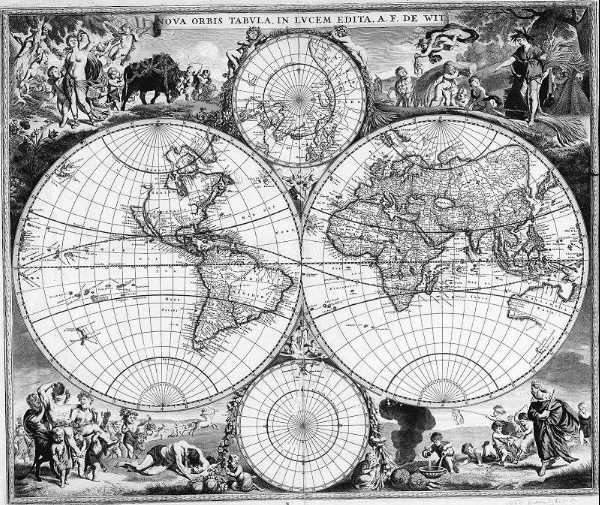Video lecture for this chapter
This material (including images) is copyrighted!.
See my copyright notice for fair use practices.
Select the photographs to display the original source in
another window.
 This chapter covers the
revolutionary advancements due to probably the most
brilliant scientist who ever lived: Isaac Newton (lived 1641--1727).
His greatest contributions
were in all branches of physics. Kepler's discoveries about elliptical orbits and
the planets' non-uniform
speeds made it impossible to maintain the idea of planetary motion as a natural one
requiring no explanation. Newton had to answer some basic questions: What keeps the
planets in their elliptical orbits? On our spinning Earth what prevents objects
from flying away when they are thrown in the air? What keeps you from being hurled
off the spinning Earth? Newton's answer was that a fundamental force called
``gravity'' operating between all objects made them move the way they do.
This chapter covers the
revolutionary advancements due to probably the most
brilliant scientist who ever lived: Isaac Newton (lived 1641--1727).
His greatest contributions
were in all branches of physics. Kepler's discoveries about elliptical orbits and
the planets' non-uniform
speeds made it impossible to maintain the idea of planetary motion as a natural one
requiring no explanation. Newton had to answer some basic questions: What keeps the
planets in their elliptical orbits? On our spinning Earth what prevents objects
from flying away when they are thrown in the air? What keeps you from being hurled
off the spinning Earth? Newton's answer was that a fundamental force called
``gravity'' operating between all objects made them move the way they do.
Newton developed some basic rules governing the motion of all objects. He used
these laws and Kepler's laws to derive his unifying Law of Gravity. I will first
discuss his three laws of motion and then discuss gravity. Finally, several
applications in astronomy will be given. This chapter uses several math concepts
that are reviewed in the mathematics
review appendix.
If your math skills are rusty, study the
mathematics review appendix and
don't hesitate to
ask your astronomy instructor for help. The vocabulary terms are in boldface.
I include images of world atlases from different time periods in this chapter
and the previous one as another way to illustrate the advances in our understanding of
our world and the universe. Links to the sites from which the photographs came
are embedded in the images. Select the picture to go to the site (will
display in another window).

Nova orbis tabula [De Wit 1688]. Select the image to go to the Hargrett Library
at the Univ. of Georgia from which this picture came. Note the curved path of
the Sun between the Tropic of Cancer (at latitude 23.5° N) and the Tropic
of Capricorn (at latitude 23.5° S).
 Go to
next section
Go to
next section
last updated:
February 21, 2022
Is this page a copy of Strobel's
Astronomy Notes?
Author of original content:
Nick Strobel
 This chapter covers the
revolutionary advancements due to probably the most
brilliant scientist who ever lived: Isaac Newton (lived 1641--1727).
His greatest contributions
were in all branches of physics. Kepler's discoveries about elliptical orbits and
the planets' non-uniform
speeds made it impossible to maintain the idea of planetary motion as a natural one
requiring no explanation. Newton had to answer some basic questions: What keeps the
planets in their elliptical orbits? On our spinning Earth what prevents objects
from flying away when they are thrown in the air? What keeps you from being hurled
off the spinning Earth? Newton's answer was that a fundamental force called
``gravity'' operating between all objects made them move the way they do.
This chapter covers the
revolutionary advancements due to probably the most
brilliant scientist who ever lived: Isaac Newton (lived 1641--1727).
His greatest contributions
were in all branches of physics. Kepler's discoveries about elliptical orbits and
the planets' non-uniform
speeds made it impossible to maintain the idea of planetary motion as a natural one
requiring no explanation. Newton had to answer some basic questions: What keeps the
planets in their elliptical orbits? On our spinning Earth what prevents objects
from flying away when they are thrown in the air? What keeps you from being hurled
off the spinning Earth? Newton's answer was that a fundamental force called
``gravity'' operating between all objects made them move the way they do.
